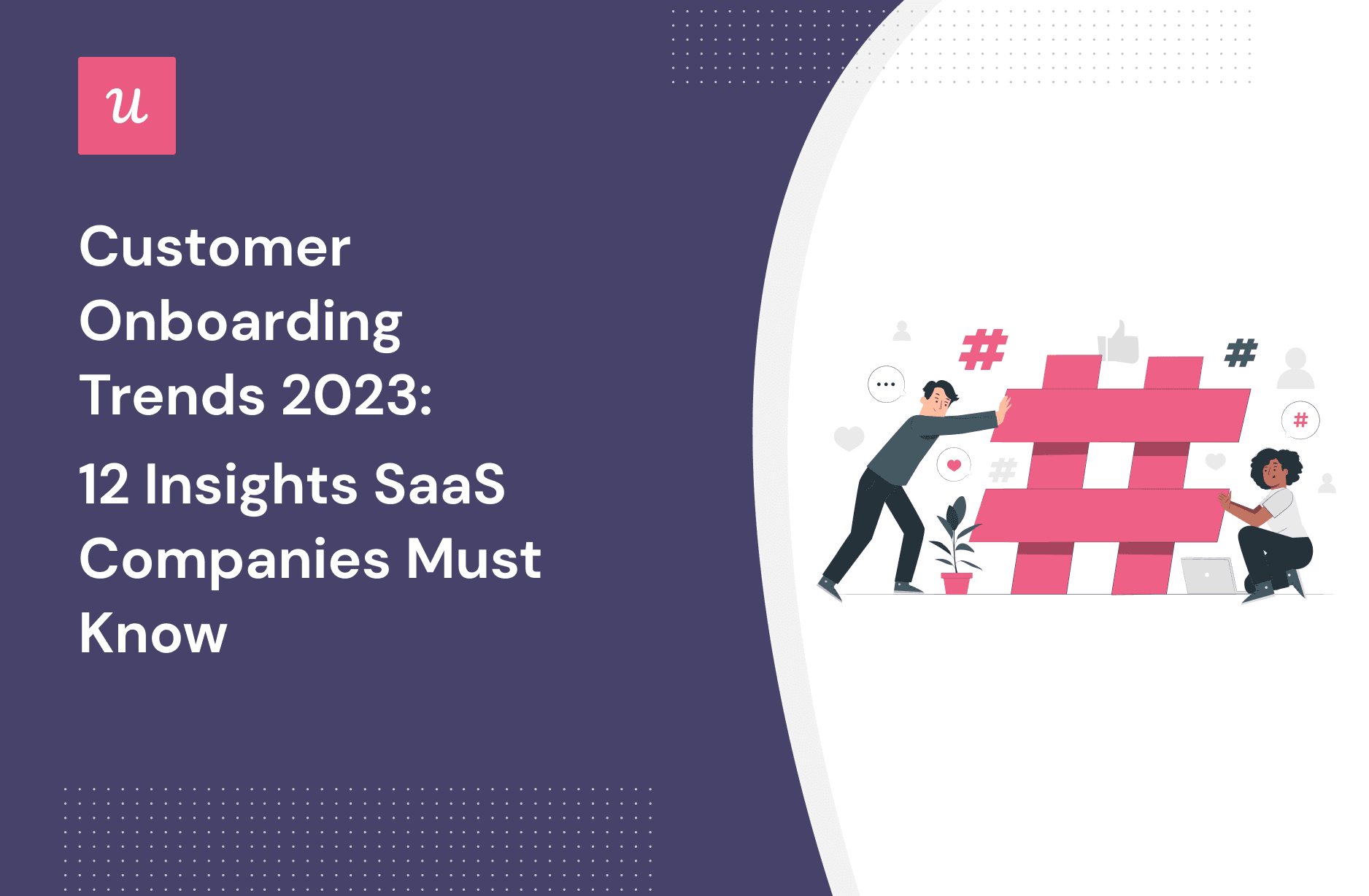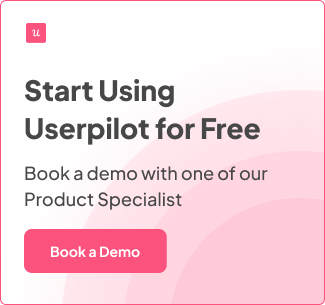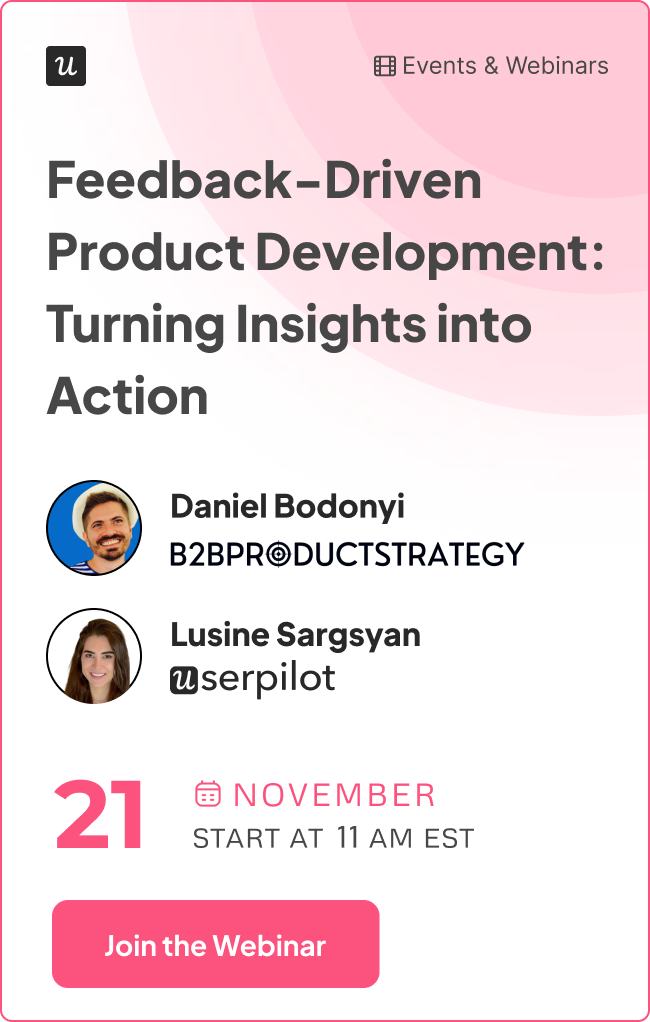Customer Onboarding Trends 2023: 12 Insights SaaS Companies Must Know

What are the main customer onboarding trends to watch out for in 2023?
If you’re after the answer to this question, then you’re in luck. Userpilot’s State of SaaS Onboarding 2023 has just landed and we’re sharing the key insights.
Fasten your seatbelts and let’s get right to it!
Overview of customer onboarding trends 2023
- Users interact with the product across different channels, so make sure to provide consistent experiences and messaging at all touchpoints.
- Frictionless sign-up flows reduce time to value, so eliminate unnecessary steps, collect only key user details, and consider enabling SSO and delaying email confirmations.
- Primary onboarding flows should be short and focused on training customers in basic functionality.
- Ongoing personalization of the onboarding experiences based on customer data, behavior, and feedback is a must.
- Engaging, enjoyable, and effective – that’s what videos are, so use them when onboarding your users.
- Look for ways to incentivize users to complete your onboarding flows, like gamification.
- Community-based onboarding relies on existing users supporting new ones. They reduce the strain on customer support teams and increase customer loyalty.
- Automation of onboarding flows and repetitive tasks are other ways to reduce customer support costs and increase retention.
- AI enables teams to analyze large quantities of user data, create captivating onboarding content and optimize onboarding flows.
- Try to create accessible onboarding experiences by localizing them, integrating immersive technologies and multimedia, and adjusting the UI appearance.
- Support your user at all stages of their onboarding journey, not just at the beginning.
- Use feedback to refine your onboarding strategy and make it work for different user segments.
- Want to see how Userpilot helps teams deliver outstanding onboarding experiences in 2023? Book the demo!
Should you follow customer onboarding trends?
The short answer is ‘Yes.’ If there’s factual evidence about what works and what doesn’t, and what your customers expect, why wouldn’t you take advantage of them?
With that being said, some trends may simply not be relevant to your use case, so don’t try to implement them just because everybody else is. Assess their impact on your business and prioritize those that will give you a better ROI.
12 Key trends to watch out for in improving your customer onboarding process
So what’s new in user onboarding in 2023?
As every year, Userpilot has analyzed the onboarding practices of over 100 SaaS tools for its State of SaaS Onboarding report, and here’s a selection of the 12 most prominent trends we’ve seen.
Creating a consistent experience across multiple channels
Customers start interacting with your product way before they sign up. For example, they may come across your social media posts or your website.
That’s why delivering a consistent experience across all the channels you use is important.
- Start by mapping out all your channels, like social media, email marketing, and in-app onboarding.
- Develop consistent messaging that clearly communicates your value proposition and highlights key features and benefits.
- Deliver a consistent user experience across various platforms (desktop and mobile, and iOS, Windows or Android, etc.).
Designing a frictionless sign-up flow for new customers
Out of the 100+ SaaS products we’ve studied, nearly 79% of them had a friction-based signup flow.
What’s the impact of that?
It delays the moment users start interacting with the product and may put off your prospective customers for good.
To create frictionless sign-up flows;
- eliminate unnecessary steps,
- collect only the essential information,
- enable single sign-on (SSO),
- and, delay the confirmation email.

Keeping the primary onboarding flow short and focused
Here’s what Bart Jaworski, the Senior PM at StepStone, thinks about primary onboarding:
“User onboarding is evolving to become more visually appealing and concise, with SaaS products transitioning away from overlay tutorials and aiming for shorter yet effective experiences.”

Basically, the onboarding process should be as short and as simple as possible, just like your sign-up flows. Your objective is to show your users the most important features so that they can start realizing the product value ASAP.
Just check out how Canva does this below.
The onboarding flow starts with a welcome survey and just one question about the user role.

Based on that, Canva personalizes your dashboard with templates that you most likely need.

Once you’ve chosen one of them, contextual tooltips guide you through the UI features to help you create your artwork.

Hyper-personalizing customer experiences
Personalization is becoming even more important in 2023. Instead of the one-size-fits-all approach that plagued onboarding for years, we can see a shift towards experiences tailored to user needs.
That’s what Lena Sesardic, the Founder of Salter Creative, believes:
“One of the key trends in SaaS user onboarding will be personalizing onboarding based on user goals, such as asking what kind of videos they want to make, is gaining traction; however, companies need to further personalize the experience after collecting user preferences, rather than just gathering data.”

And with the tools that we have available, this is becoming easier to accomplish.
How do you do it?
- Use welcome surveys to collect customer data and track product usage.
- Use the insights to design bespoke onboarding experiences.
- Focus on contextual event-based onboarding messaging to deliver guidance relevant to the particular stage of the user journey.

Incorporating videos when onboarding customers
Text is not enough to create engaging onboarding resources anymore. Videos are becoming the norm.
Here’s what Harshal Patil, a Product Consultant at Spark Creative Technologies, thinks about the trend:
“SaaS companies will be increasingly utilizing videos over text documentation for tutorials. Some SaaS products eschew an onboarding tutorial with one video. The video walks through all parts of the product for the customer. Broadly this fits in the theme of preference of users to watch video tutorials over text documentation.”

The good news is that it’s easier than ever to create videos, courtesy of AI. With tools like Synthesia, you can generate custom video materials in a very quick and cost-effective way.
Using gamification to increase customer engagement in-app
Matteo Aliotta, the CEO & Head of Growth at LTV, believes that users need active encouragement and incentives to engage with and complete onboarding flows:
“In my experience as the CEO & Head of Growth at LTV, I find that using templates for onboarding is highly effective. It’s also essential to give value to users before they sign up, which can encourage them to engage with your product. Moreover, I’ve observed that incentivizing activation and sharing during onboarding plays a crucial role in user adoption and growth.”

One way to do this is by introducing elements of gamification. Why not try these tricks?
- Allow users to choose avatars during sign-up.
- Implement a system of badges and points for reaching milestones in the user journey.
- Use leaderboards and encourage competition between users.
- Use checklists and offer variable rewards for completing each step.

Leveraging community-based onboarding
One of the challenges of user onboarding and support is the strain it puts on the customer support and success teams. Dealing with customer tickets requires time and resources.
That’s why companies are trying to shift some of the burdens to user communities they build around their products.
How does it work?
Iuliia Shnai, the Founder of MarbleFlows, sums this up;
“Implementing the community in onboarding can be the way to make users onboard each other.”
Basically, giving customers access to a community where existing customers can answer all their questions and help them overcome issues can increase adoption and customer retention later on.
Notion’s Ambassador program is one example of this growing trend.

Using automation to streamline the onboarding process
Another way to reduce the time and costs required for user onboarding is to automate your processes.
How can you automate the onboarding process?
- Use chatbots to provide real-time support.
- Set up automated flows to guide new users through the onboarding process.
- Automate repetitive tasks such as data entry, document creation, and account setup.
- Create automated reminders, like failed payment warnings to avoid involuntary churn.

Implementing artificial intelligence to improve the customer experience
AI-powered tools have the potential to truly revolutionize the way we do customer onboarding.
Emilie Lindström, a Product Coach & Value Rebels at Product at Heart, couldn’t agree more:
“The future of user onboarding lies in AI-driven, dynamic processes that learn, adapt, and guide users while being transparent about the learning mechanisms behind it, making AI an interesting and useful aspect for customers.”

How can you harness the power of AI to enhance the customer experience?
- Analyze user data to better personalize their onboarding.
- Create captivating copy that resonates with users.
- Optimize user onboarding flows based on their behavior and feedback in real-time.
Creating accessible user onboarding for different customers
Product success requires adoption across all user categories, not just the most innovative and tech-savvy ones. This means SaaS companies must do a lot more to make their products more inclusive and accessible to users with unique needs.
Here are a few ideas on how to do it:
- Build diverse teams to better understand users from different backgrounds.
- Localize the user experience across all touchpoints in the customer journey.
- Integrate immersive technologies like text-to-speech readers and voice recognition.
- Use multimedia to present information.
- Make your UI more accessible by adjusting color patterns and typography.
Focusing on making continuous onboarding a priority
Customers have different onboarding needs depending on what stage in the customer lifecycle they are in.
Initially, the objective is to train users to use the key features so that they can start using the product and experiencing its value. It doesn’t stop there though.
Once they get familiar with the basic features, it’s time for secondary onboarding and helping them discover more complex functionality relevant to their use cases.
And once your users adopt the product and become loyal users, you may want to think about how to maximize account expansion opportunities and leverage their dedication to promote your product through WOM or referral programs.
Each stage requires a different approach, which should be reflected in your onboarding strategy.

Incorporating customer feedback to improve the onboarding experience
Customer feedback is essential to optimize the onboarding process.
Customer success teams should trigger surveys during the onboarding process to gauge the level of customer satisfaction and identify ways for improvement.
Based on the insights, they should adopt different strategies to personalize the experience for unhappy and/or unsuccessful customers.
How can Userpilot help you achieve customer onboarding success?
Userpilot is a product adoption platform that allows you to create bespoke onboarding experiences for your users.
Its key features include:
- User surveys for collecting data to customize their experience and to track satisfaction levels.
- Feedback widget for collecting passive feedback.
- A range of UI patterns for in-app messaging (tooltips, modals, banners, driven actions, and hotspots).
- Multi-step guides (interactive walkthroughs and checklists).
- Resource center functionality for on-demand self-support.
- User segmentation for targeted triggering of onboarding flows.
- Product usage analytics to track user engagement and adjust onboarding to their needs.
- AI-powered WYSIWYG editor for creating and improving your microcopy.

Conclusion
Some of the customer onboarding trends of 2023, like focusing on personalization, creating frictionless sign-ups, and developing communities around products are a continuation of what we’ve seen in the previous years.
However, widespread access to AI gives you a chance to streamline your current processes to a completely new level and opens new avenues for exploration and innovation.
If you want to see how Userpilot can help your SaaS optimize and enhance user onboarding, book the demo!

